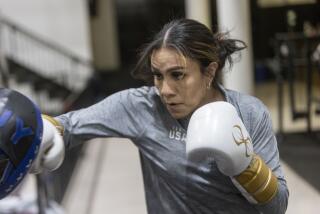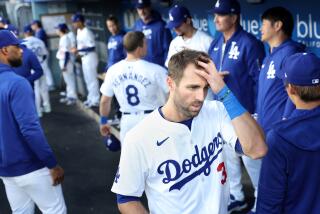Food Fight : Meldrick Taylor Loves to Eat Almost as Much as He Loves to Box, but He’s Winning That Battle, Too
- Share via
LAS VEGAS — When Meldrick Taylor burst upon the amateur boxing scene as a mid-teen in the tough, gritty gyms of Philadelphia, boxing people there weren’t sure what they had.
Was he a future featherweight champion or a future heavyweight champion?
He sure could fight, everyone acknowledged. But he could eat like Orson Welles, too. Some even gave him a shot at evolving into another Buster Mathis, who made a good run through the heavyweight division during the 1970s.
Luckily, however, Taylor’s gym ethic was such that he could work off the Twinkies, cheeseburgers, Cokes, potato chips and pizzas.
By 1984, he was already a solid candidate to make the U.S. Olympic team as a featherweight--125 pounds. In a key test that year, he had to face the great Cuban, Adolfo
Horta, at the USA-Cuba matches in Reno in February.
Horta was in his late 20s and a three-time world champion. Taylor was 16.
The night before the matches, U.S. Olympic Coach Pat Nappi prowled a hotel corridor, making unannounced room checks. He burst in upon Taylor and found him in bed with . . . a giant pizza.
Furious, Nappi threw out the pizza. Then, at high volume, pointed out to Taylor that he was only hours away from a weigh-in for the most important boxing engagement of his life.
Taylor made weight the next morning, possibly because Nappi posted a sentry outside the fighter’s room to guard against pizza deliverymen.
Taylor went on to the Los Angeles Olympics and became one of the Games’ youngest gold medalists. He turned pro three months later and has lost only once.
Saturday night, at the Mirage, he faces his toughest challenge since his last-second defeat by Julio Cesar Chavez two years ago.
Taylor, with a 29-1-1 record, meets Terry Norris (31-3) for Norris’ World Boxing Council junior-middleweight championship. And this time, Taylor’s people vow, his eating ethic has matched his gym ethic.
In Philadelphia, Taylor’s gym workouts are the stuff of legend.
“I used to work out at the same health club Taylor did,” Philadelphia columnist Bill Lyon said.
“He came in from six or seven miles of roadwork one day, immediately got on the Stairmaster machine next to mine, set it to the ‘death zone’ setting (the highest possible) and did 30 minutes without holding onto the railings. I’ve never gotten over that.”
Given that kind of work ethic, some in boxing wonder if Taylor wouldn’t be a more formidable fighter at, say, 135 or 140 pounds, on a leaner diet.
Saturday’s fight is at 150 1/2 pounds, even though the junior-middleweight maximum is 154. Dan and Lou Duva, Taylor’s promoter and trainer, wouldn’t take the Norris fight unless all agreed on a weight midway between the welterweight limit, 147, and 154. Taylor holds a piece of the welterweight championship, but it isn’t at stake Saturday night.
Through his eight years with the Duvas, it’s been one victory--and one battle over eating--after another.
Taylor’s trainer, Lou Duva, certainly shouldn’t be lecturing anyone on proper nutrition. At 5 feet 8, he carries around one of boxing’s most spectacular paunches. But he’s 68, and Taylor is 25.
“For the first time, I think, we don’t have to worry about what Mel’s eating,” Duva said Wednesday. “He’s finally got his head on straight over food. He weighs 148, 149 right now. He weighed 150 ten days ago. So it looks like we’ll have no problem with the weight.”
Taylor and heavyweight champion Evander Holyfield joined Duva at the same time in 1984 and both were fast-food and snack-food junkies, Duva said.
“You’d walk into Evander’s room and the place would be full of potato chips, candy bars and pizza. But with Evander, once we had a nutritionist explain to him the right way to eat, that was the end of it.
“With Meldrick, it’s taken years. We’d lecture him about fresh fruit, steamed vegetables, pasta with tomato sauce . . . and he’d nod his head, then drive straight to a McDonald’s.
“Once, at a training camp for a fight, I went out and bought a half-dozen oranges, a half-dozen apples, a couple of pounds of grapes. I gave them to him and said: ‘Here, eat this while we’re here.’
“A few hours later, I asked him where all the fruit was and he said he’d eaten it, like I’d told him. I said: ‘Mel! Not at one sitting! ‘ “
Taylor had to make 140 pounds for the only fight he has lost, his epic match with Chavez in March of 1990.
“I lost too much (weight) too close to that fight,” he said of the crushing defeat, when Chavez beat him in the final seconds of the fight. Referee Richard Steele stopped it with two seconds remaining, awarding victory to Chavez. Taylor was ahead on all the judges’ scorecards at the time.
Two days before that fight, Taylor seemed too lean. Spectators at his last workout could count all of his ribs.
“I was dehydrated the last three rounds against Chavez,” Taylor said the other day. “I fought him on heart alone.”
On that night, Taylor gave all he had--and then some. Some still wonder if he will ever be the fighter he was before that fight. He spent the night of the loss to Chavez in a Las Vegas hospital, where doctors found a fracture near his left eye.
He also needed a transfusion to replace two pints of blood he lost from a mouth cut.
Although both Chavez and Taylor absorbed considerable punishment that night, Chavez seemed relatively unharmed. He had only a nick on his nose, whereas Taylor’s entire face was swollen. Taylor, who lives in Cherry Hill, N.J., has fought five times since the Chavez war, with mixed results. He was tentative and unaggressive in his next outing, winning a lackluster decision over Primo Ramos at Stateline, Nev.
Co-trainer George Benton was also unhappy with Taylor’s next outing, a decision over Aaron Davis nearly a year after the Chavez fight.
“He won decisions, but he wouldn’t take it to Ramos or Davis in the late rounds,” Benton said.
“If that was from the Chavez fight, I don’t know. But you can bet he’ll do what I tell him Saturday.”
Since fighting Davis, from whom he won the World Boxing Assn. welterweight title, Taylor has beaten Luis Garcia, Ernie Chavez and Glenwood Brown. He was down twice against Brown but won a unanimous decision.
Taylor once had a high knockout percentage, but since Chavez he has stopped only one of five opponents.
His task Saturday is a formidable one. He is moving up in weight and, in theory at least, will fight a bigger, stronger athlete who has won 10 in a row, four of them defenses of his championship.
And to those who say he has lost something since Chavez, Taylor says they are wrong.
“I haven’t lost anything since that fight,” he said. “The people who say I’ve lost something don’t understand me as a fighter. Fighters don’t look great every time. With the exception of Michael Jordan, no professional athlete can always be at his best.”
Taylor says he wants to springboard from a victory over Norris to boxing’s biggest paydays. He will earn $2 million Saturday. Norris gets $1.3 million.
“A win over Norris will propel me to being the boxing superstar of the ‘90s,” he said.
“After that, I want a rematch with Chavez. If I can’t get that, then I’ll fight anyone in the middle weight classes.”
More to Read
Go beyond the scoreboard
Get the latest on L.A.'s teams in the daily Sports Report newsletter.
You may occasionally receive promotional content from the Los Angeles Times.










